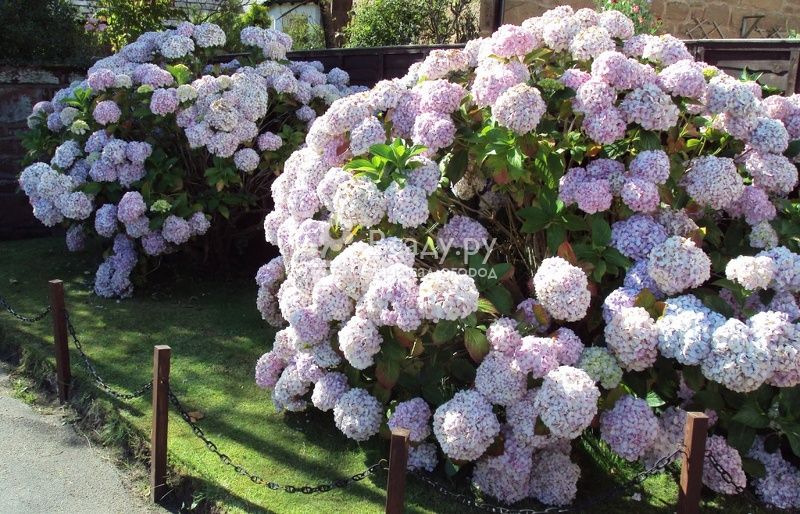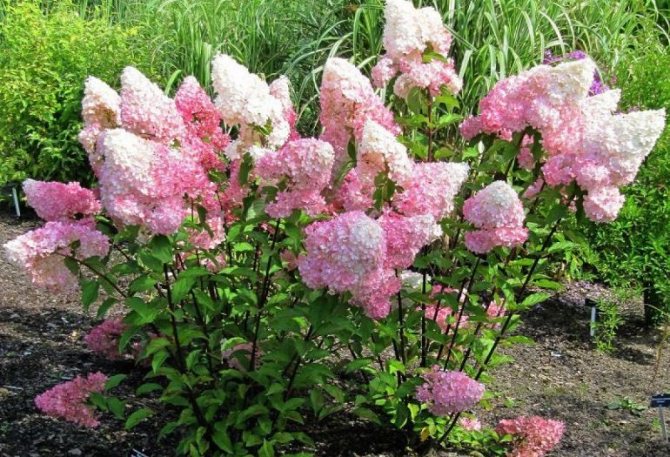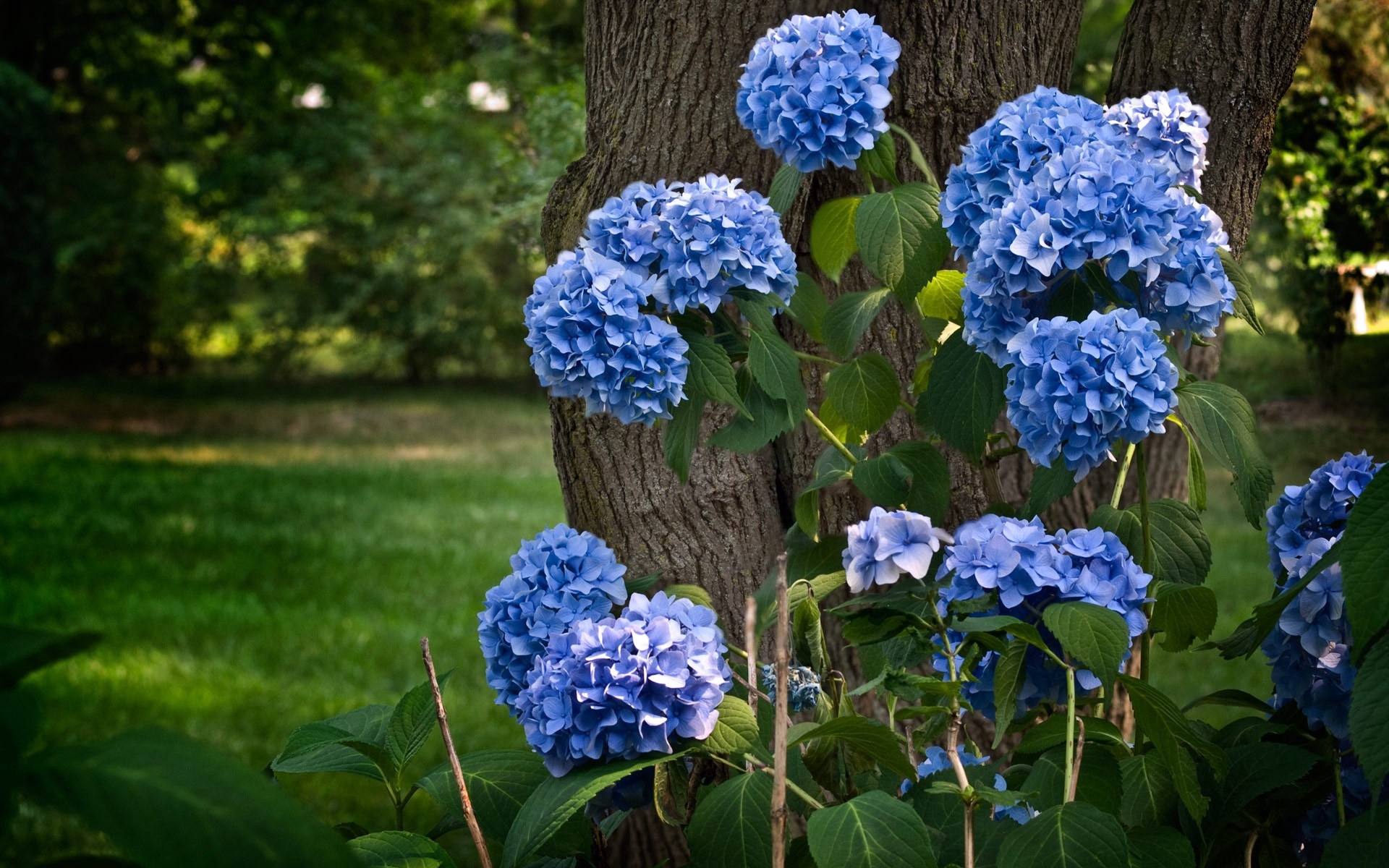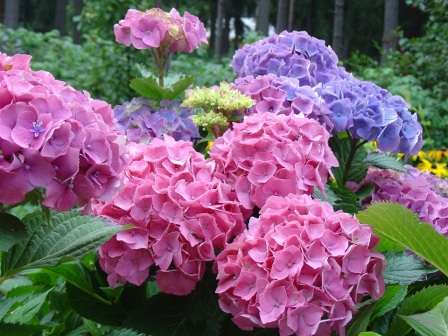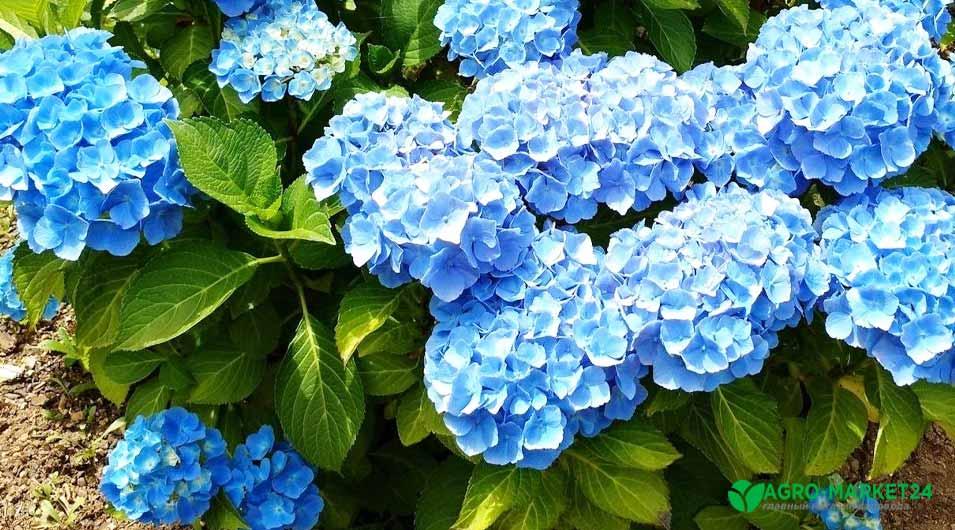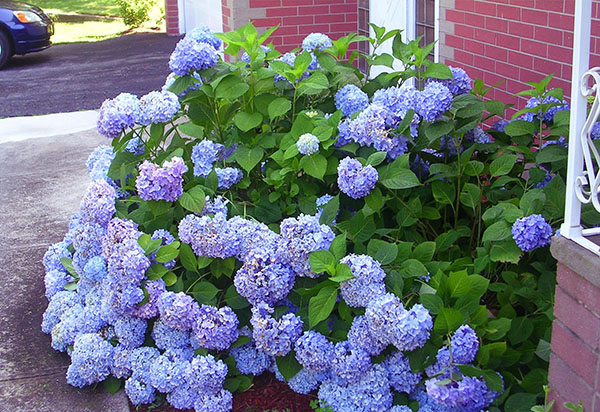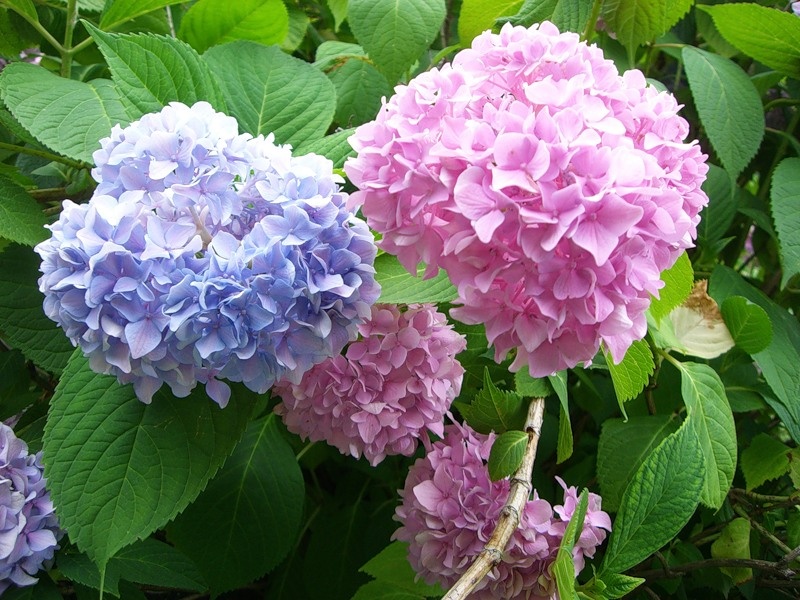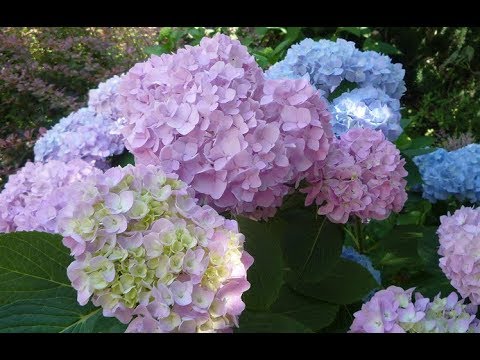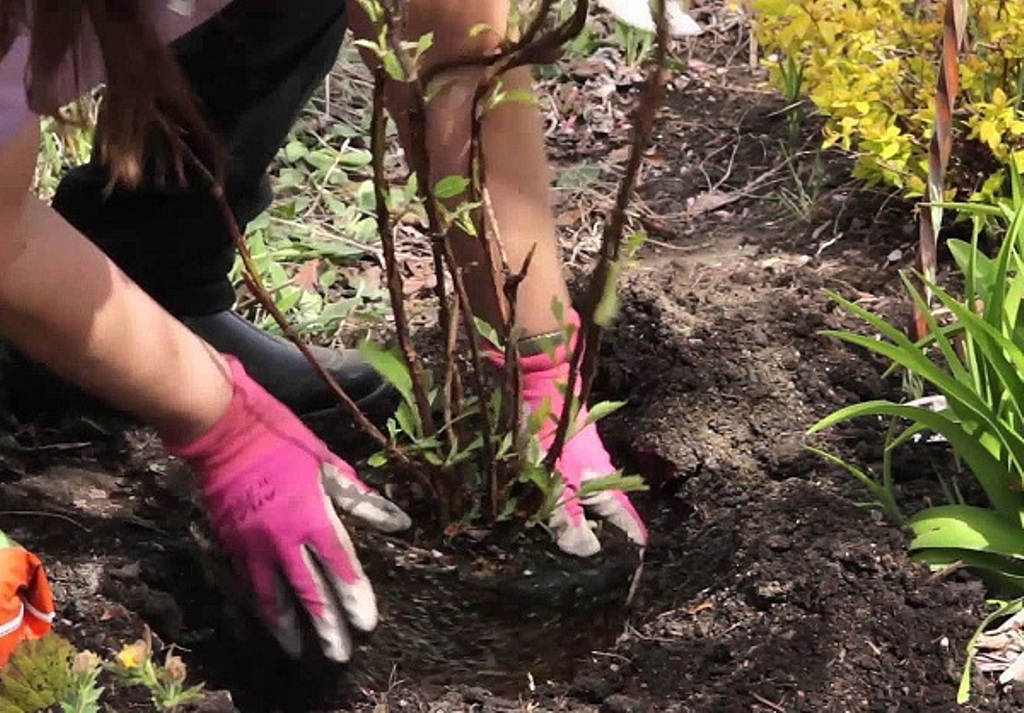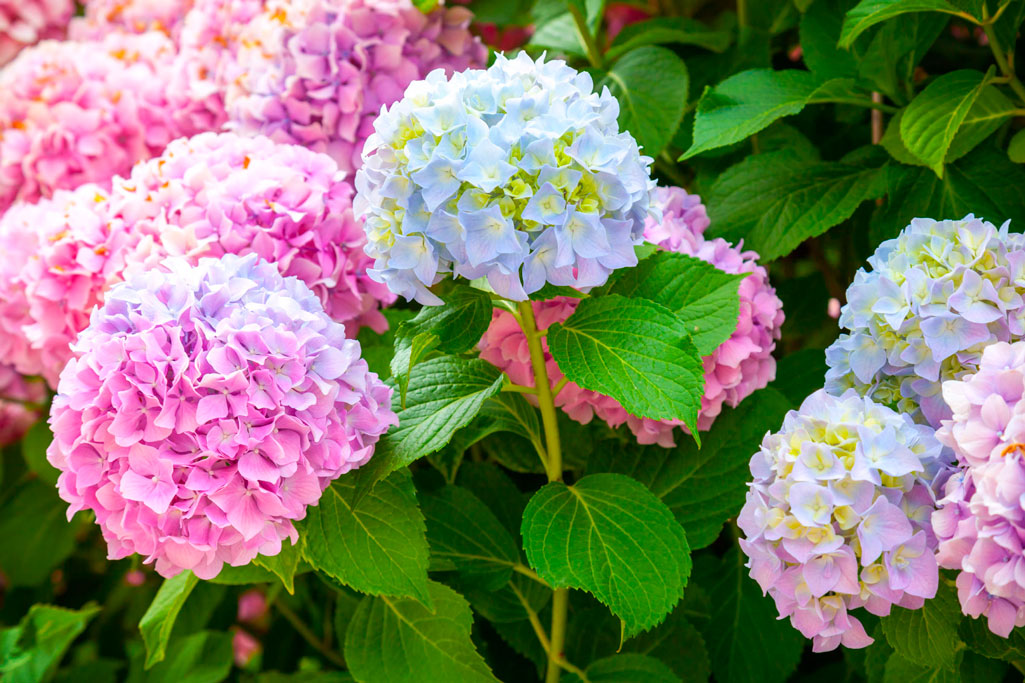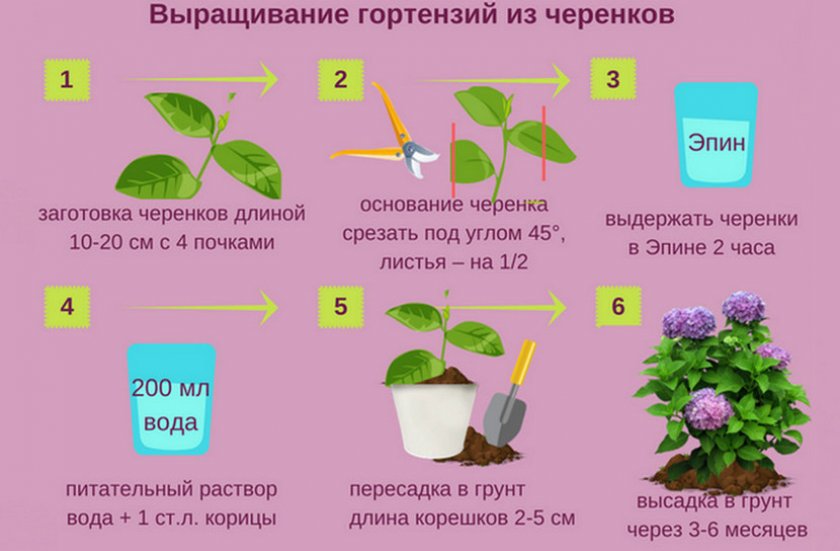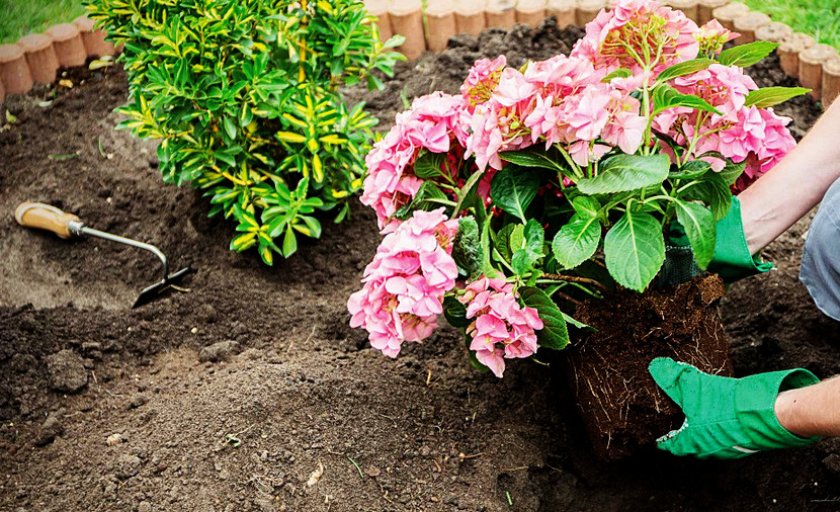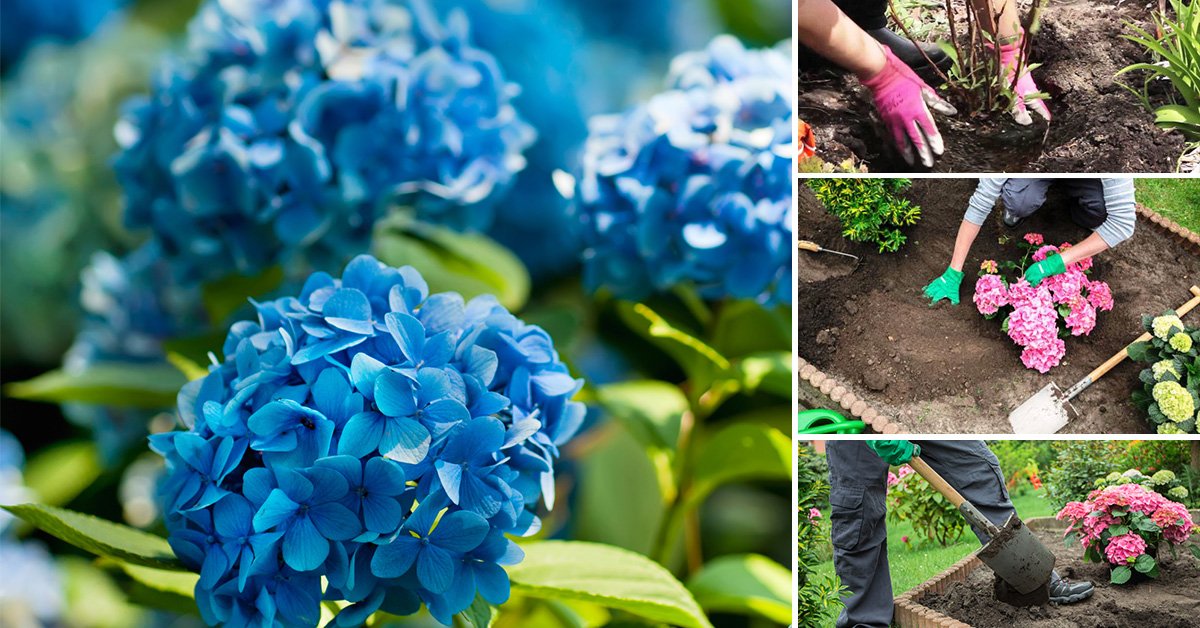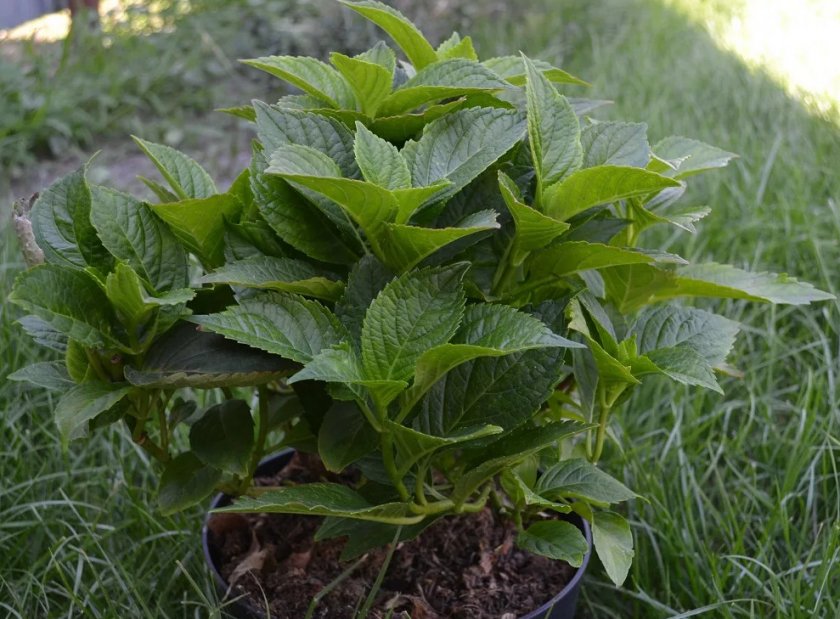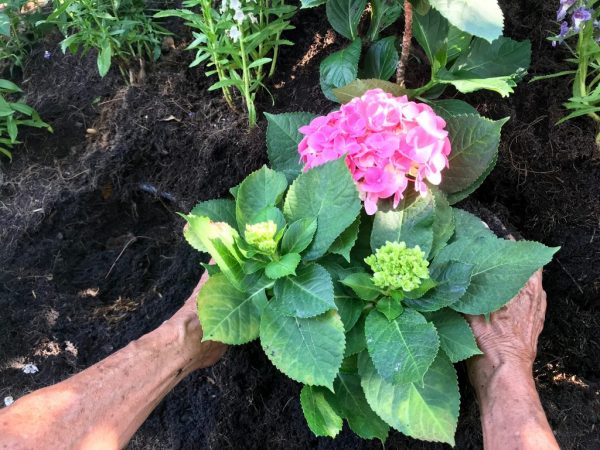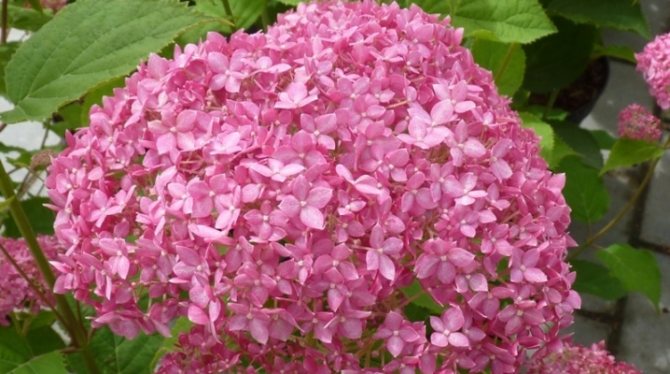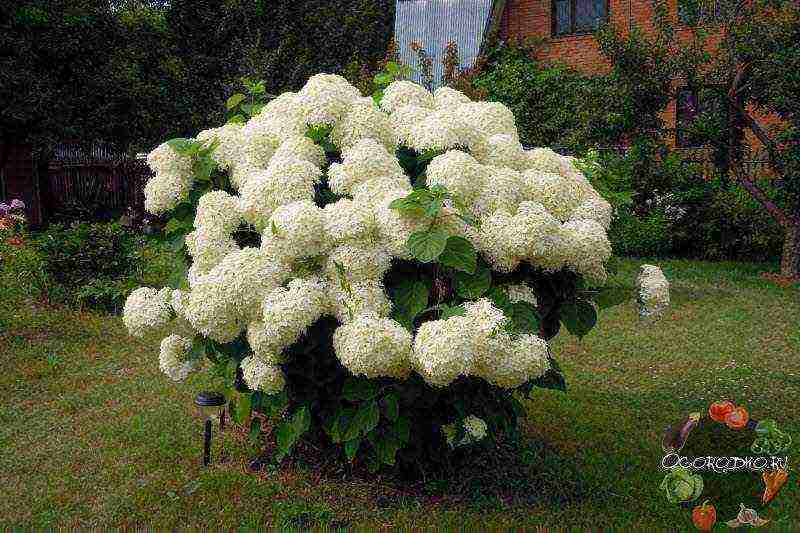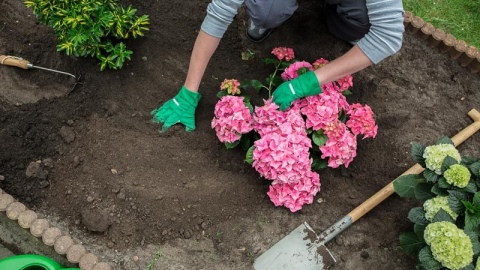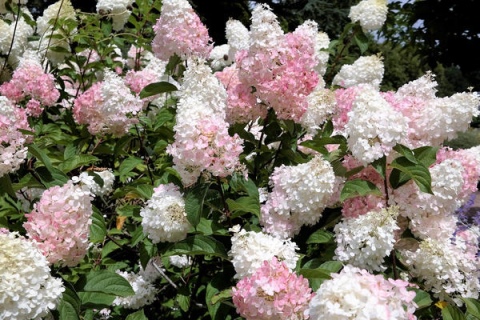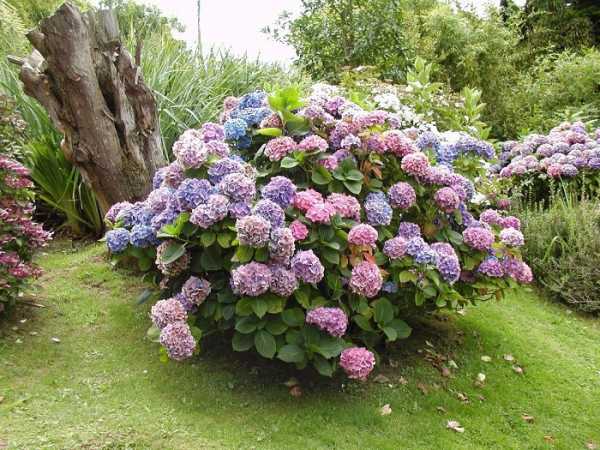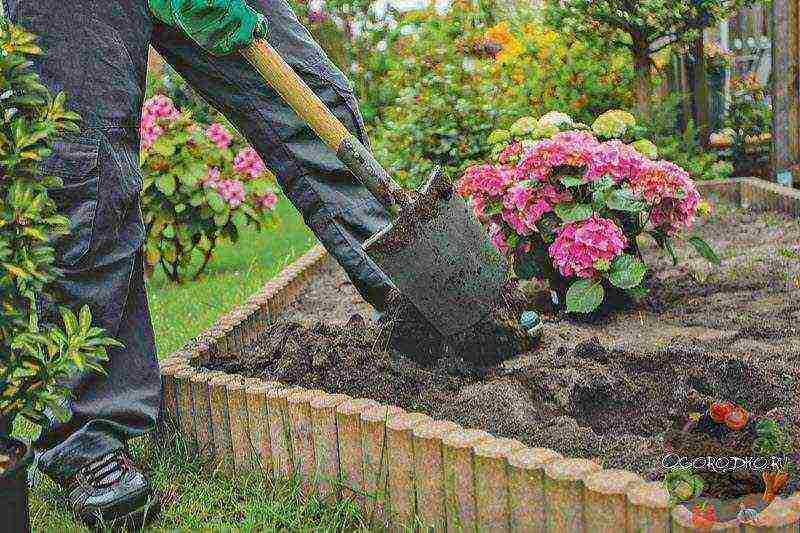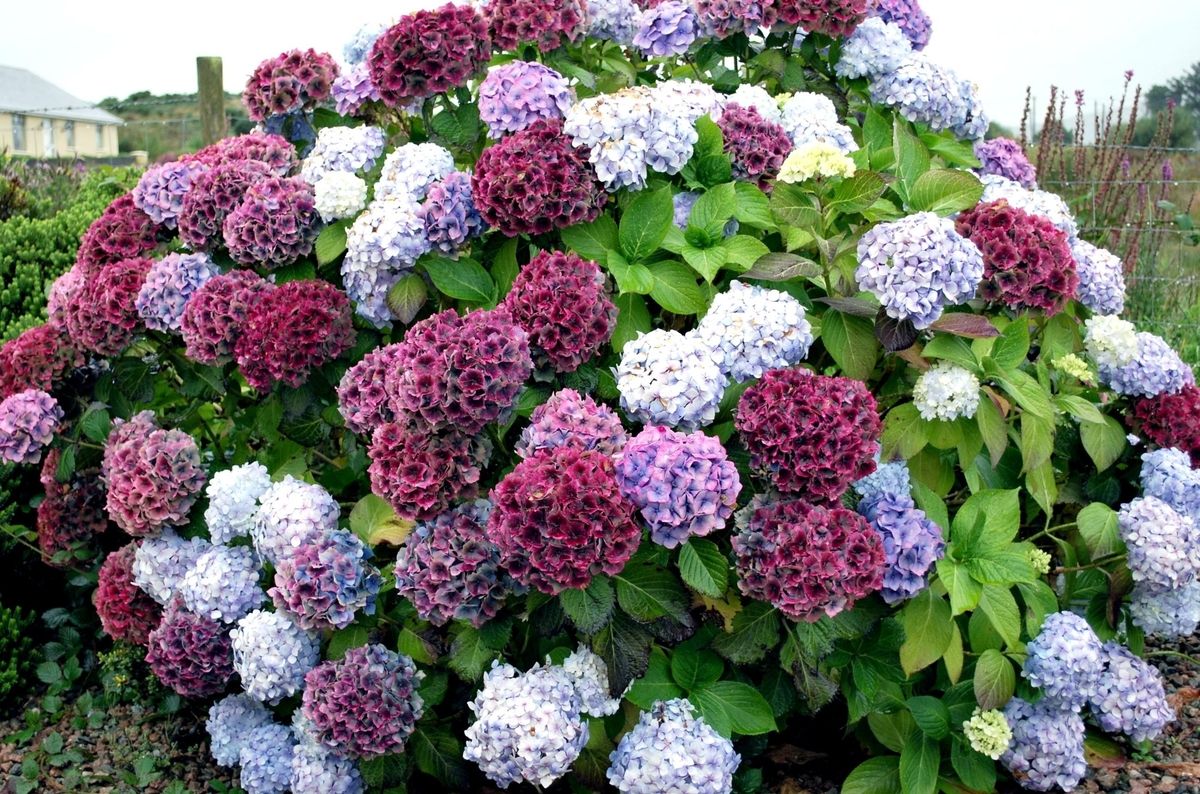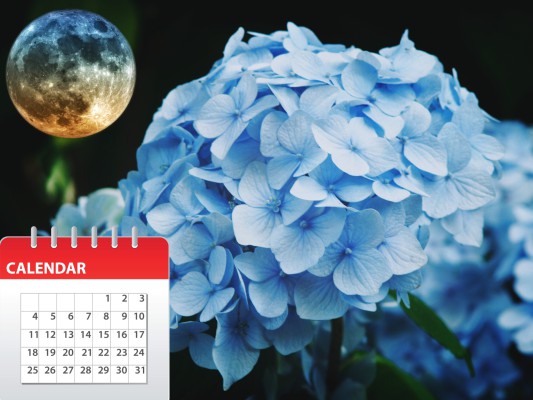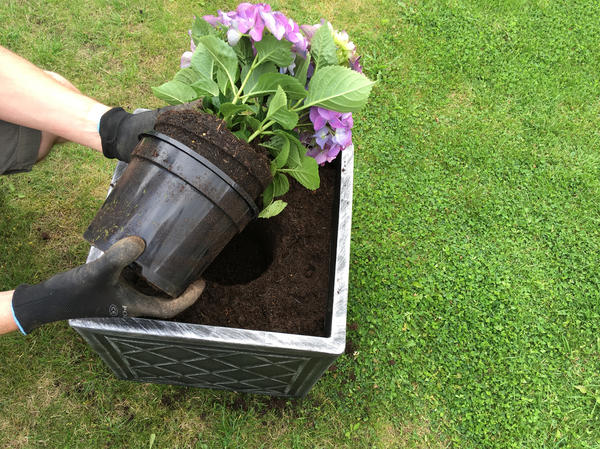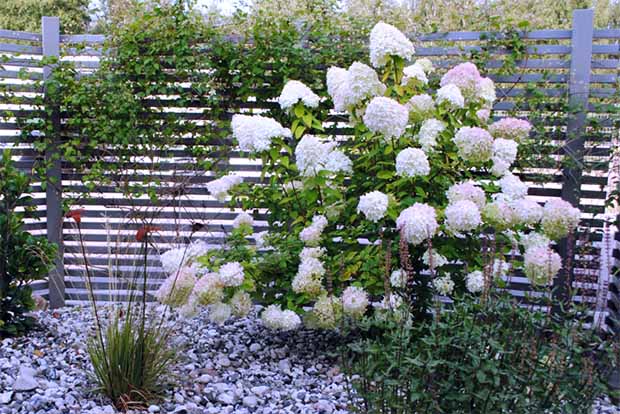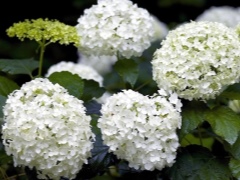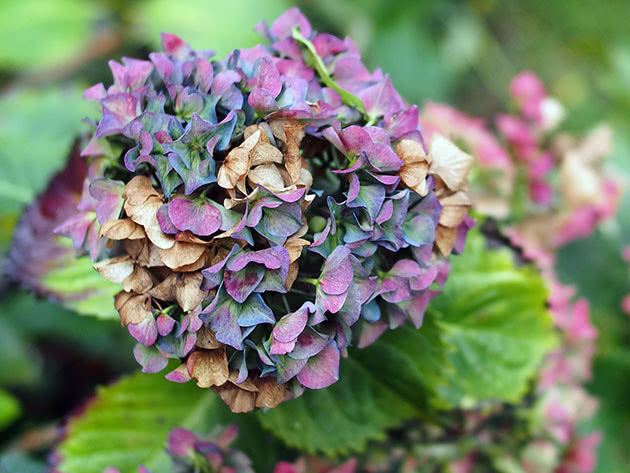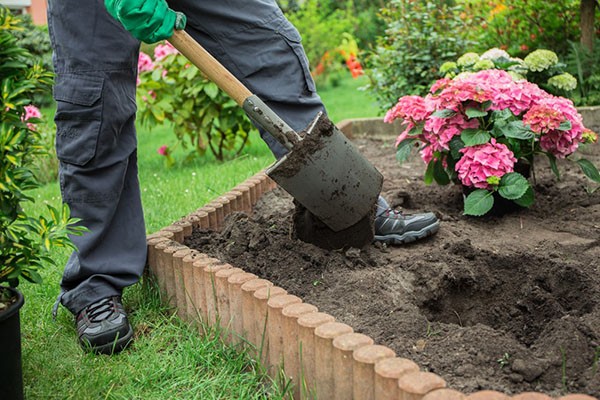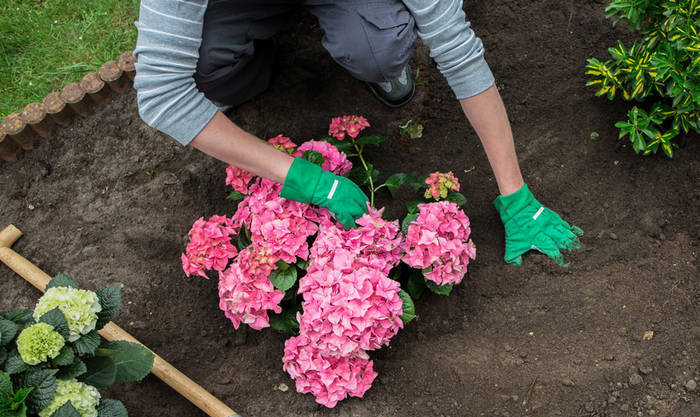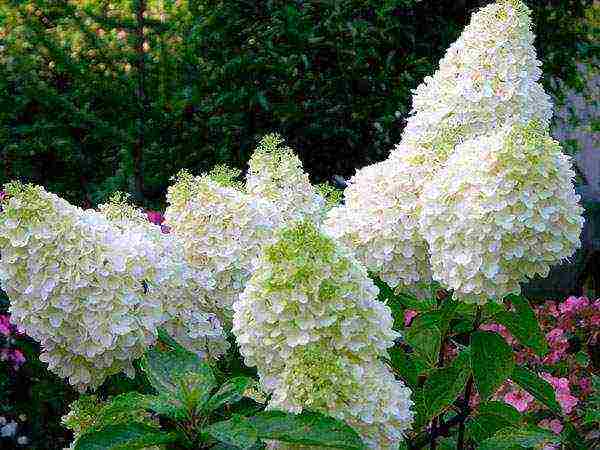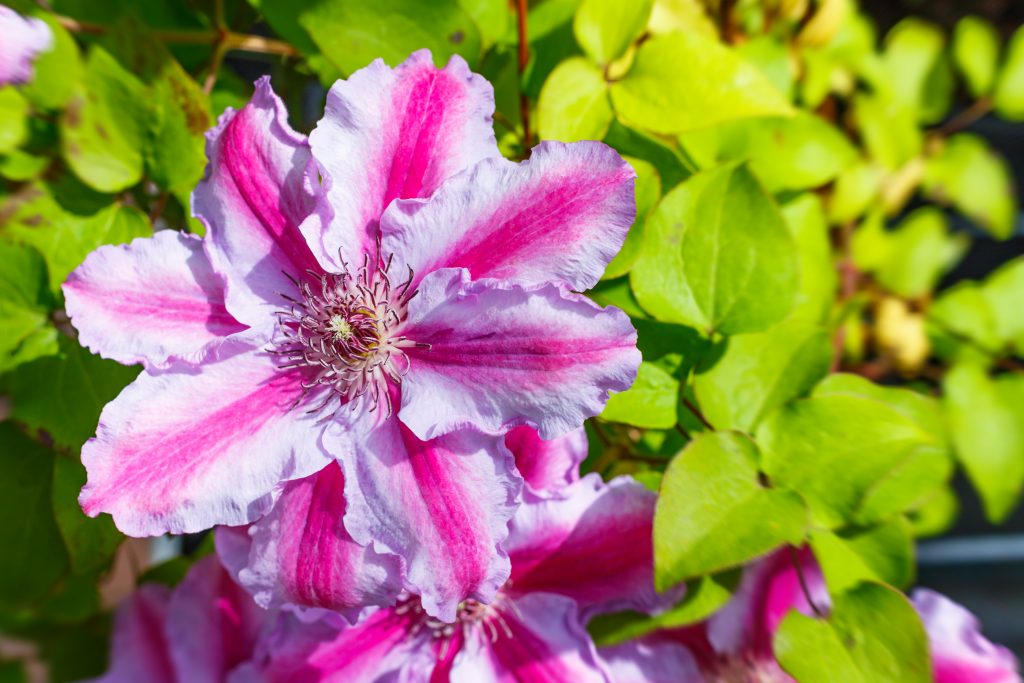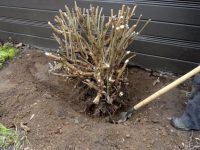Fertilizing hydrangea
Like most plants, I fertilize hydrangea four times.
for the season.
I do the first feeding in the spring, when the ground warms up and the first leaves appear.
- Pre-acidify the soil by spilling water with the addition of citric acid.
- I spread two tablespoons into a bucket and spill it over the bucket under the bush.
- At this time, the plant needs nitrogen for the growth of green mass. But with an excess of nitrogen, the hydrangea does not bloom well, and the inflorescences become green in color.
- For 10 liters of water, you need to take 20 g of urea and 30 g of superphosphate and potassium sulfate. Superphosphate must first be poured overnight with hot water as it does not dissolve well.
- I usually fertilize with nitroammophos - 20g per 10L of water.
It is good to feed the currants with a slightly pink solution of potassium permanganate in a bucket under the bush.
- I spend 5 dressings per season with an interval of two weeks, starting in May.
- Along with mineral fertilizers, I also add organic fertilizers.
- I water the infusion of manure or green fertilizer from nettle in a bucket on a bush.
- I fill the manure with water in a ratio of 1:10 and insist for a week.
- Then I spread 1 liter of manure in a bucket of water.
- I water with organic fertilizers until mid-summer.
The second top dressing is carried out at the beginning of budding, I apply fertilizers, where phosphorus and potassium prevail. Phosphorus contributes to the development of the root system and the formation of buds. Potassium is responsible for the quality of flowering, color of flowers. I use monopotassium phosphate - 1 tablespoon per bucket of water acidified with 2 tablespoons of citric acid - 5 liters per bush. At the same time I spill infusion of herbs, 1 liter per 10 liters of water.
I spend the third feeding at the first opening of the buds.
- I spill it with potassium permanganate.
- A week later, with a solution of monopotassium phosphate, in the same way as with the second feeding.
- At this time, magnesium is needed for high-quality flowering and brightness of hydrangea flowers. I dilute 1 teaspoon in 10 liters of warm water and spill it over the sheet.
- A few hours before dressing, I spill the earth.
- Usually I water it in the evening, and in the morning I feed it.
The fourth feeding is carried out
in September. Nitrogen must not be added during this time. The plant needs phosphorus and most importantly
potassium for good wintering. I take 2 tablespoons of superphosphate for a bucket of water
and potassium sulfate. After ten days, potassium magnesium is 20 g per 10 liters of water.
But I think,
that instead of mineral dressings it is easier to make
specialized fertilizers for hydrangeas and rhododendrons, in which
contains all the necessary elements. How
I already wrote, for garden hydrangeas I use special fertilizers for blue
or red hydrangeas. Autumn bushes
I mulch with coniferous litter or pine needles with a layer of 15 cm.
This is all that I wanted to tell you about the beautiful hydrangea, which, along with the rose, bears the proud name of the queen of the garden. Even a few of these adorable plants will decorate your garden and make it admirable.
I hope you enjoyed this article, Hydrangea: Planting and Nursing Outdoors (PHOTOS). Please read our article Roses: Outdoor Planting and Care for Newbies in the Moscow Region. (PHOTO)
Join our group on Odnoklassniki to receive announcements of new articles directly to the feed.
Planting hydrangeas
Planting can be done in early spring or autumn. If you are a gardener, then you probably know that with proper care you can get not only a shrub up to 2 meters high, but also a beautiful plant that can delight you with its beauty for more than one year.
But if this is your first time planting it, you cannot do without the subtleties of proper planting and care.
All hydrangeas are shade-tolerant. If you choose a place where sunlight constantly falls, then it will lose turgor. Therefore, it is necessary to choose a place where there is sunshine until lunchtime. She can also adapt well to partial shade. But remember that in dense shade, it will not be able to please you with its lush flowering.
Timing
It is best to plant and transplant hydrangeas in the spring, but can also be planted in the fall. Timing will depend on the location. If this is a cold area, planting is carried out after the snow melts. But if you have a warm region, you can plant it in the fall.
It is important that the plant has time to take root before the onset of cold weather.
Seat selection
In order to choose the right site, follow the rules:
- choose a place near a house or fence;
- the place should not be too windy;
- the place should not be too sunny, openwork shade is welcome
By adhering to these rules, you can find the right place.
It is important that the earth is well moistened. If there are significant deviations from these recommendations, then it will be difficult to get the necessary flowering, and the desired type of bush
Soil preparation
The flower is undemanding to the composition of the earth, but prefers acidic soil. Poorly tolerates excess lime, in alkaline soil it can die. Doesn't really survive in soil with a lot of manure. It is considered acceptable to be planted in the ground from a mixture of peat, sand and humus in a ratio of 3: 1: 1.
Experienced gardeners acidify the soil with a solution of oxalic or citric acid in water. Proportion: 1 tablespoon of acid per 10 liters of water, you can use 9% table vinegar, also 1 tablespoon per 10 liters of water or a slightly pink solution of potassium permanganate.
Before acidifying the earth, determine the level of acidity of the soil, the optimum for hydrangea is considered to be pH - 5.2 - 6.0. If the pH is close to 7-7.5, then it is necessary to acidify the soil. Experienced gardeners have a pH meter and it can also be useful to you, but it can be easily replaced with a paper guide (litmus paper), which is sold in special stores.
The hydrangea has slightly green leaves, and the veins remain green - this is chlorosis. The reason is the insufficient acidity of the soil, while the plant does not absorb iron. The plant must be fed first with a solution of potassium sulfate (1 tablespoon per 10 liters of water), and then with a solution of ferrous sulfate in the same concentration.
Open ground planting process
The soil is initially prepared. Having prepared, we are looking for a place according to all the rules. Planting near trees is not recommended as they draw a lot of moisture from the ground.
Landing is carried out in several stages:
- Dig a hole. The root system of hydrangeas is shallow, therefore a pit depth of 40 cm is sufficient, and since the root system gradually grows in breadth, the required feeding area should be at least 50 × 50 cm, and preferably 80 × 80 cm.
-
Place the mixture to the top in the dug hole. This is a mixture of:
- sand - 1 part;
- sour high-moor peat - 3 parts;
- humus - 1 part.
-
Fertilizers from:
- urea;
- potassium sulfide;
- humus;
- superphosphate.
When planting, mineral fertilizers should not be applied under the roots, as they inhibit the survival of the roots. It will be even more important not to use lime (ash) and manure
Landing is done as follows:
- the roots must be well spread. trim slightly, diseased and damaged cut;
- place the seedling in the hole so that the root collar is 3-4 cm below the soil level;
- add the earth gradually, constantly wetting it with water;
- mulch, preferably with a coniferous litter, which will retain moisture and gradually rotting, give the roots physiologically acidic nutrition
But what do you do when a plant needs to be transplanted for a special design in your landscape? It is better to do this process in the fall (early), so that it has time to take root before the cold weather.Try to carefully dig it up so as not to damage the roots, remember that hydrangea has an extensive superficial root system
Important! Never transplant it during the flowering period. This can lead to death, and you will no longer be able to enjoy the exuberant bloom.
If you want to plant several hydrangeas, then the distance between them should not be less than 1–1.5 meters from each other.
Autumn pruning - what you need to know about preparing for the winter?
In autumn, the preserved inflorescences are cut off, because thanks to them, snow will accumulate in excess on the bushes, under the weight of which fragile branches can not only bend, but also break off. For old bushes, rejuvenating pruning is relevant, during which perennial wood is removed. Already in the second year, most of the shrubs are restored, continuing to delight everyone with abundant flowering, with the help of which they will fit into any landscape design.
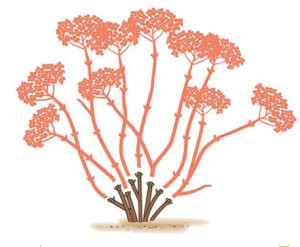
Macrophile is not subject to pruning! The bushes only occasionally rejuvenate - for this, damaged and diseased branches are removed annually, if there are none, it is enough to remove every fourth branch. In case of non-observance of this rule, the plant will grow, but it will not please with flowering.

Other frost-resistant varieties of hydrangea for Siberia
Not only panicle hydrangea is suitable for Siberia. There are frost-resistant varieties both among the treelike hydrangea and among the large-leaved ones.
Treelike hydrangea varieties that are resistant to low air temperatures:
Annabelle is a short plant, no more than 120 cm, blooming with white inflorescences. Transfers temperatures down to -28⁰С. At lower temperatures, it needs to be transplanted into a separate container and transferred to the basement.
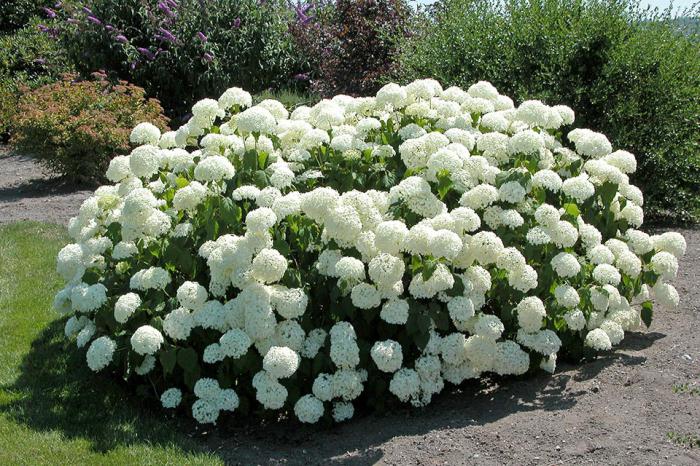
Annabelle globular inflorescences
Strong Annabelle is a common hydrangea species in Siberia. The shape of the inflorescences differs from the standard ones. Most often they look like a dome. The flowers are large, white. By the end of flowering, they acquire a slightly greenish tint. Transfers temperatures down to -34⁰С. The plant is 1 m 50 cm high.
Varieties of frost-resistant large-leaved hydrangea:
- Schloss Wackerbart - transfers temperatures down to -28⁰С. It is grown outdoors in the southern part of Siberia. It does not require transplanting for a colder period; it will be enough to provide the plant with a dry shelter. It reaches a height of 1 m 30 cm. The color of the plant changes constantly. Flowering period is 2.5 months, from mid-summer to late September.
- Forever & Ever - reaches a height of 1 m.At the beginning of flowering, it has a bluish tint, which becomes a deep blue by mid-September. For the winter period, requires a potting or shelter. Withstands temperatures up to -25⁰С.
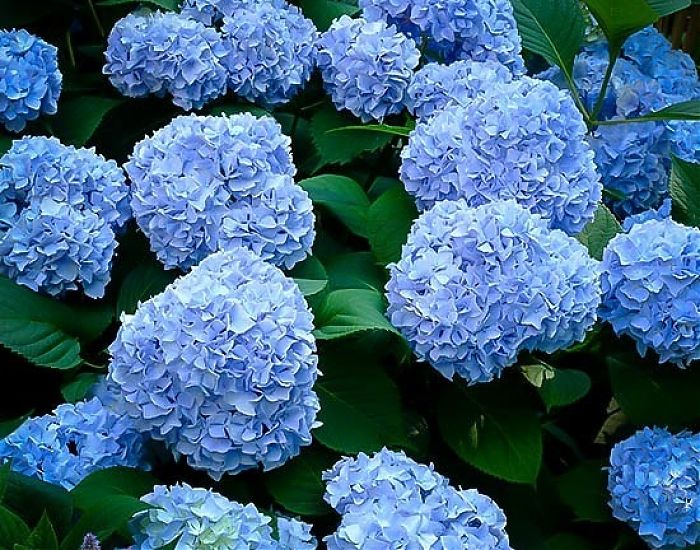
Forever & Ever inflorescence color
One should not be afraid to plant these varieties in the Urals. Due to the similar climatic conditions, they will bloom well.
Propagation of hydrangea in autumn
How to propagate hydrangea in the fall
Hydrangea propagates by cuttings, layering, offspring, dividing the bush and the method of dropping the seedling. Let's say right away that cuttings of hydrangeas are not carried out in the fall - the plant is propagated by green cuttings in the middle of summer. And all other methods are very convenient to use for breeding in the fall, in September or October.
Dividing hydrangea in autumn
This breeding method is more often used when transplanting hydrangeas. All species are propagated in this way, except for panicle hydrangea. We have already described how to dig up a hydrangea, and when the bush is already removed from the soil, its root is divided so that in each division there are developed healthy roots and shoots. It is possible that you will have to use an ax, so be careful. Process the cuts on the roots with crushed charcoal and transplant the cuttings into pre-prepared pits.
Propagation of hydrangea by layering in autumn
This method is simple, but unproductive. However, it is not necessary once at a time, so it is worth trying it too.Dig the soil under the bush in the place where you are going to divert the low-growing branch of the hydrangea, then make a groove 15 cm deep in the soil, lay a shoot in it and attach it to the soil with metal pins, and then fill the furrow with loose soil. Pinch the top of the shoot and leave it above the surface. Cover the layers with leaves or spruce branches before freezing.
In the spring, shoots will begin to grow from the cuttings, and when they reach a height of 20 cm, huddle them, and then repeat the hilling every time the shoots add 7-10 cm in height.As soon as the height of the earthen hill rises to 25 cm, dig out the cuttings, separate it from the bush, cut it between the young shoots, and then plant them.
Propagation of hydrangea by offspring in autumn
When propagating hydrangeas by shoots, you should be careful and attentive. Remove the top layer of soil and separate the coppice shoot, being careful not to damage the roots of the mother bush, then plant the shoot for growing for one or two years, and then transplant to a permanent place
Propagation of hydrangea by dropping a seedling
This method of breeding hydrangeas appeared not so long ago, but has already gained both supporters and fans. It consists in the fact that a hydrangea seedling is used as a cutting. Tear off all the leaves on it, cut off the unripe shoots, remove it from the container and bury it in a deep trench prepared in advance with a sloping bottom in this way: lower the seedling into the trench, bury its roots in the deepest place, compact the soil well, then fan the shoots and also cover them with earth. Cover the surface with a layer of humus or peat.
With the onset of spring, the buds on the shoots of the seedling will grow. First, the young shoots will be fed by the root system of the seedling, and then each of them will acquire its own roots. This method of propagation allows you to get ten small hydrangeas with a well-developed root system from one seedling.
Caring for shrubs planted in autumn
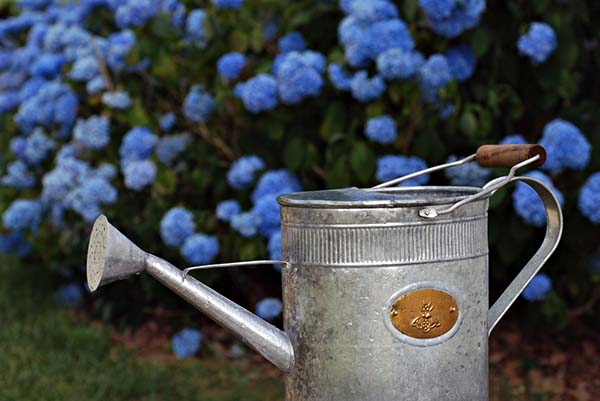
You can reduce the risk of plant disease by pruning old branches
The subsequent care of the hydrangea is not particularly difficult and consists mainly of regular watering, if necessary. Since the weather is predominantly rainy in autumn, there is a high risk of developing fungal infections of the plant. Therefore, preventive treatment of plantings is carried out once a month (until the first frost): they spill the earth in the near-trunk circle with a manganese solution.
For tree hydrangea, potassium permanganate is an effective top dressing. As a result, the shoots become stronger and thicker.
It will be useful to acidify the soil at least twice during the autumn period with a mixture of citric acid, vinegar or any other means of a similar effect.
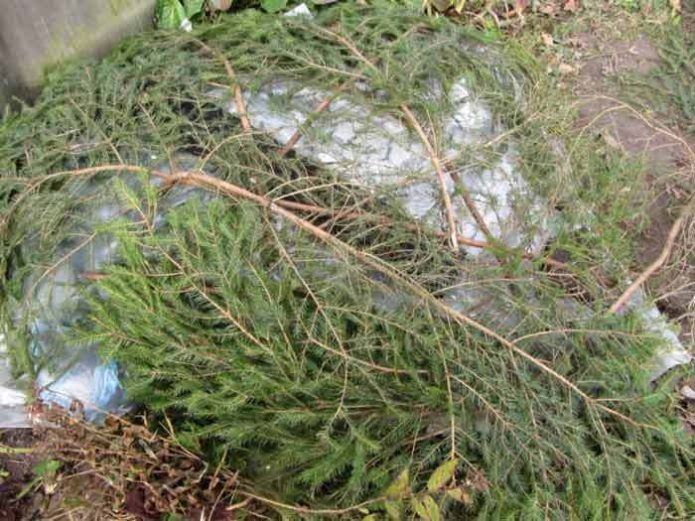
An adult plant can do without shelter in the future.
A large-leaved hydrangea needs shelter for the winter. This can be done in two ways:
- Remove all foliage and prune the shoots to the fifth knot. Underdeveloped stems are cut to the base.
- The bush is tied with twine and bent to the ground, where it is fixed. Coniferous spruce branches are thrown on top and covered with lutrasil or other similar material.
The rest of the varieties (tree, paniculate) do not require frost protection. But so that the shoots do not break under the weight of the snow cover, they are tied into a bunch. And also the bush is spud and a layer of mulch from sawdust or plant litter is scattered under it.
Video: Useful tips from an experienced gardener for planting hydrangeas
In order for the hydrangea to successfully take root in the garden, it is important to initially correctly approach the process. This means the correct choice of seedlings and location, adherence to planting technology and subsequent care.
When is it better to plant hydrangea - in autumn or spring?
This plant can be planted in spring and fall. The gardener is free to choose a time convenient for himself, taking into account all the pros and cons of planting.
Planting in spring
The main advantage of the spring planting of hydrangeas and other perennials is the warm weather, which allows the plant to successfully adapt to a new place. In the northern regions of our country, where autumn is cold and short, most perennials are recommended to be planted in spring.
The disadvantages of early spring planting include the demanding plants for frequent watering and the need to shade seedlings if hot weather is established.
Large-leaved hydrangea, as the most thermophilic, is recommended to be planted only in spring. This advice applies to young plants obtained from cuttings this season. They should be transplanted in the spring.
Planting in autumn
Planting hydrangeas in the fall is possible, provided that the seedling is well developed. The bush is placed in the soil at least 4 weeks before the onset of frost, which can penetrate 10-15 cm into the soil.
The advantage of autumn planting can be considered favorable air and soil humidity due to autumn rains and comfortable, not hot weather.
For autumn planting, you should choose a seedling with a closed root system.
When to plant hydrangea in open ground in the fall according to the Lunar calendar
In 2020, favorable days for autumn planting are as follows:
- September —9-11, 16-21, 24-25
- October - 3-8, 13-15
Plants are not disturbed on full and new moon days.
In the spring of 2020, it is recommended to plant hydrangea in the ground on the following dates:
- April - 1, 2, 5-7, 9, 13-15, 24, 25
- May - 2-6, 15-17, 20, 21, 25-31
Compliance with the dates of planting and other work with plants in accordance with the lunar calendar allows the gardener to avoid problems with pets. On favorable days, flowers and saplings tolerate transplanting and pruning more easily, the harvested seeds show high germination.
Planting time of hydrangeas, depending on the region
The climate of our country is diverse and the timing of planting hydrangeas in the fall in open ground can vary significantly.
In the Central lane and the Moscow region, panicle and tree hydrangea are planted in September. This is done depending on the weather, at the beginning and middle of the month.
In the Leningrad region, the shrub is placed in a flower garden in early and mid-September. The moist climate of the hydrangea region is only beneficial. It is a rare plant that loves moisture in the soil.
In the Urals and Siberia, with their short autumn, the climate is not favorable for the autumn planting of hydrangeas. Although experienced gardeners point to the possibility of planting the plant at the end of August, provided that it is developed: the trunk and branches are fully ripe and have a good root system.
In these regions, for the winter, it is necessary to insulate the hydrangea with spruce branches, fallen leaves, wood shavings and lutrasil.
South of Russia is characterized by long warm autumn and mild winter. In these latitudes, hydrangea is planted in October. And even large-leaved hydrangea seedlings will take root when planting in the fall.
In Ukraine, the climate is similar to the weather in the southern regions of Russia, the timing of planting perennials in autumn is the same. This is the end of September - October.
In Belarus, hydrangea is placed in the open field from mid-September to early October, depending on the prevailing weather.
A gardener who takes his plants seriously should keep a notebook of his weather observations. Significant weather phenomena are annually introduced into it: snow melt in spring, end and beginning of frost, amount of precipitation, maximum and minimum temperatures during the year. Analysis of these observations will help to identify a favorable time for planting and other work with plants in a particular area.

